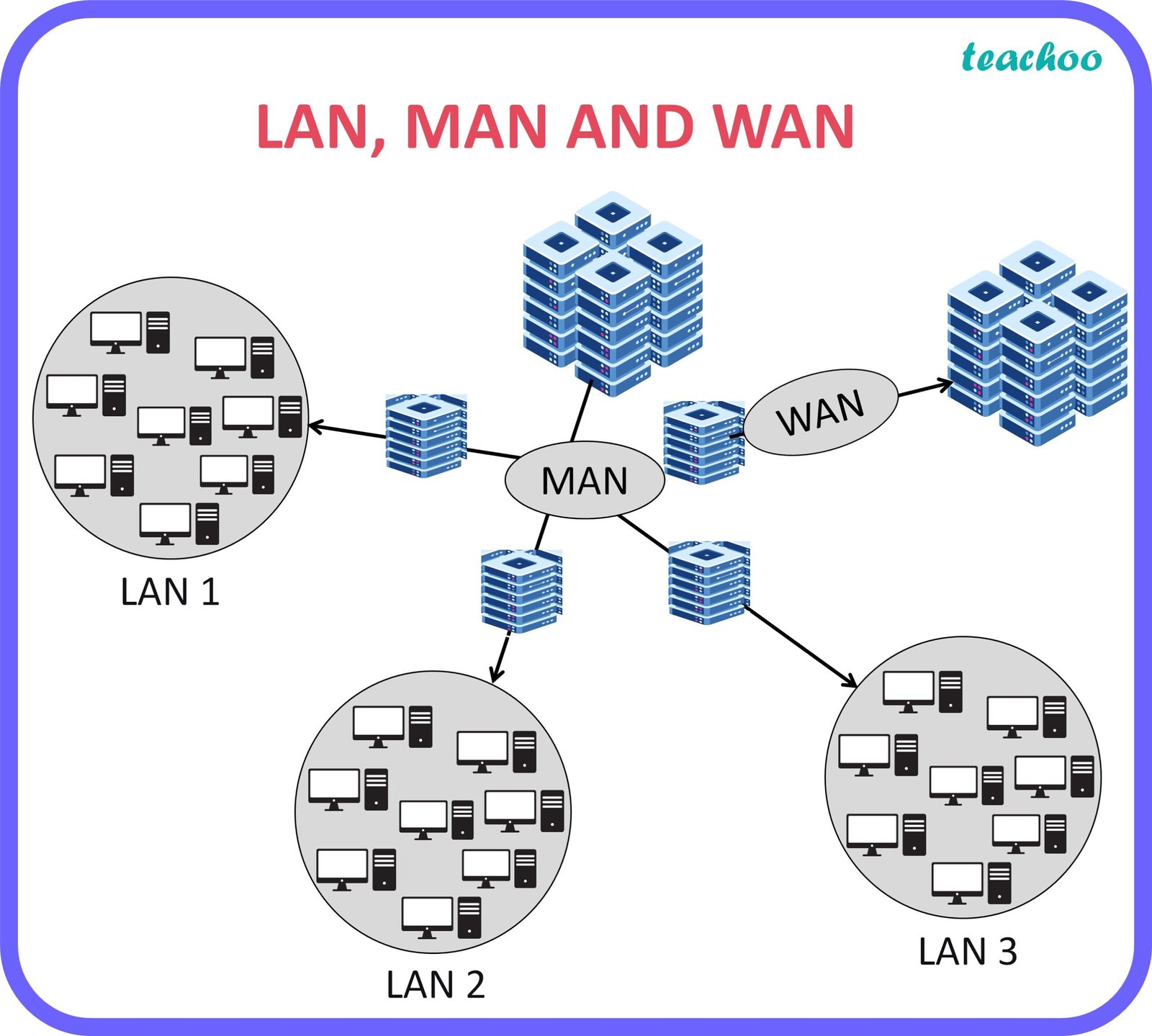Understanding LAN, WAN, and MAN: Key Types of Network Architectures
In the world of networking, understanding the different types of network architectures is crucial for designing, managing, and optimizing communication systems. LAN (Local Area Network), WAN (Wide Area Network), and MAN (Metropolitan Area Network) are three fundamental types of networks, each serving specific purposes and covering different geographical areas. This article explores the characteristics, uses, and differences between LAN, WAN, and MAN networks.
Local Area Network (LAN):
Definition and Characteristics: A Local Area Network (LAN) is a network that connects computers and devices within a limited geographical area, such as a home, office, or campus. LANs are designed for high-speed data transfer and low latency, making them ideal for environments where devices need to communicate frequently and efficiently.
- Coverage: LANs typically cover a small geographic area, ranging from a single room to a building or campus.
- Speed: LANs offer high-speed connections, often ranging from 10 Mbps to 10 Gbps, depending on the technology used (e.g., Ethernet).
- Ownership: LANs are usually privately owned and managed by individuals, businesses, or institutions.
- Technology: LANs commonly use Ethernet cables, Wi-Fi, and switches/routers to connect devices and facilitate communication.
Uses:
- Home Networks: Connecting personal computers, smartphones, smart TVs, and other devices within a household.
- Office Networks: Linking workstations, printers, servers, and other office equipment to enable file sharing and collaborative work.
- Educational Institutions: Providing network connectivity for students and staff in schools and universities.
Advantages:
- High Speed: LANs offer fast data transfer rates, which are beneficial for tasks requiring high bandwidth, such as streaming and file transfers.
- Low Latency: Low delay in data transmission enhances real-time communication and responsiveness.
- Cost-Effective: Setting up and maintaining a LAN is relatively inexpensive compared to larger network types.
Wide Area Network (WAN):
Definition and Characteristics: A Wide Area Network (WAN) spans a large geographical area, often covering cities, countries, or even continents. WANs connect multiple LANs and other types of networks to enable communication over long distances.
- Coverage: WANs cover extensive geographic areas, from multiple locations within a country to global connections.
- Speed: WANs typically have lower speeds compared to LANs due to the larger distances involved. Speeds can vary widely, from a few Mbps to several Gbps.
- Ownership: WANs can be owned and operated by telecommunications companies, businesses, or governments.
- Technology: WANs use technologies such as leased lines, satellite links, and MPLS (Multiprotocol Label Switching) to connect distant locations.
Uses:
- Corporate Networks: Connecting branch offices, remote employees, and data centers across different regions.
- Internet: The global network that connects millions of LANs and other networks worldwide.
- Government and Military: Linking various government agencies and military bases for secure communication.
Advantages:
- Geographical Reach: WANs enable communication over vast distances, connecting geographically dispersed locations.
- Scalability: WANs can accommodate a large number of connections and can be expanded to include more sites as needed.
- Redundancy and Reliability: WANs often have multiple redundant paths to ensure reliable connectivity and minimize downtime.
Metropolitan Area Network (MAN):
Definition and Characteristics: A Metropolitan Area Network (MAN) is a network that covers a larger geographic area than a LAN but smaller than a WAN, typically spanning a city or a large campus. MANs are designed to provide high-speed connectivity within metropolitan areas.
- Coverage: MANs cover a city or a large urban area, connecting multiple LANs and providing services within that region.
- Speed: MANs offer high-speed connections, often ranging from 1 Gbps to 10 Gbps, depending on the infrastructure.
- Ownership: MANs can be owned by telecommunications companies, municipalities, or private organizations.
- Technology: MANs use technologies such as fiber optics, leased lines, and wireless links to provide high-speed connectivity within the city.
Uses:
- City-Wide Networks: Providing internet access and networking services to businesses, government offices, and educational institutions within a city.
- Public Wi-Fi: Offering wireless internet access in public areas such as parks, libraries, and transportation hubs.
- Campus Networks: Connecting multiple buildings and departments within a large university or corporate campus.
Advantages:
- High-Speed Connectivity: MANs provide fast and reliable network access within urban areas.
- Cost Efficiency: MANs can be more cost-effective for city-wide networks compared to WANs.
- Flexibility: MANs support various applications and services, including public Wi-Fi and enterprise connectivity.
Comparing LAN, WAN, and MAN:
- Geographical Coverage: LANs cover small areas (home, office), MANs cover cities or large campuses, and WANs cover vast regions (countries, continents).
- Speed: LANs generally offer the highest speeds, followed by MANs, and then WANs, due to the larger distances and infrastructure involved.
- Ownership and Management: LANs are typically privately owned, MANs may be managed by municipalities or businesses, and WANs are often operated by telecom companies or large organizations.
Conclusion:
Understanding the differences between LAN, WAN, and MAN is essential for designing effective network solutions tailored to specific needs. LANs provide high-speed connectivity within localized areas, WANs connect remote locations over long distances, and MANs offer high-speed access within metropolitan areas. Each network type serves distinct purposes and is crucial for enabling communication and information sharing in various contexts. By leveraging the strengths of each network type, organizations and individuals can achieve efficient and reliable connectivity tailored to their requirements.










